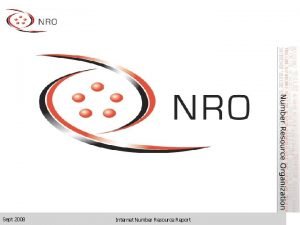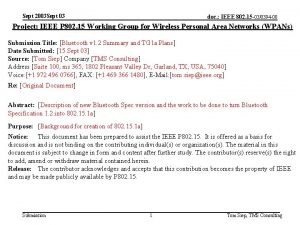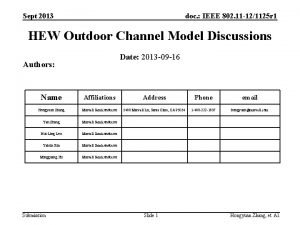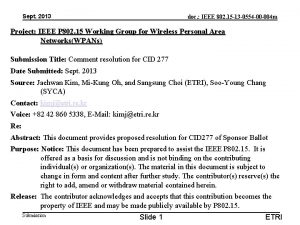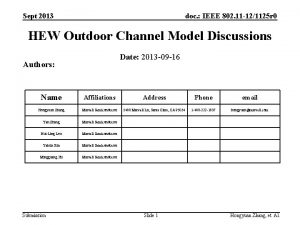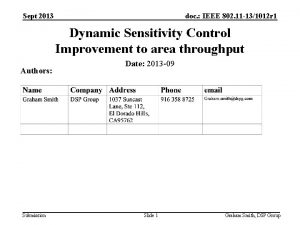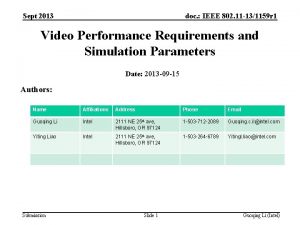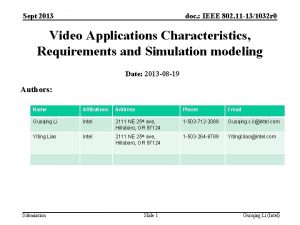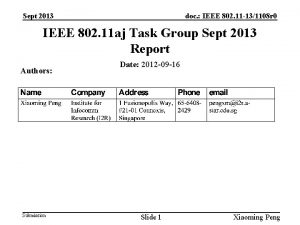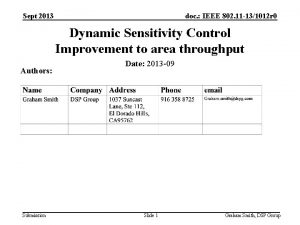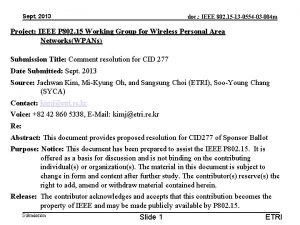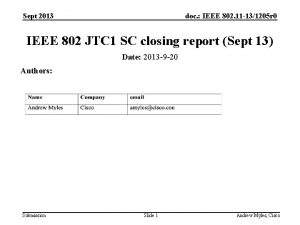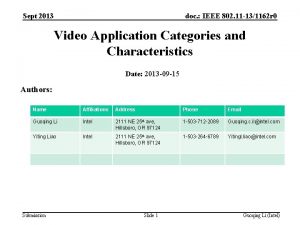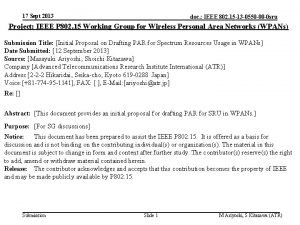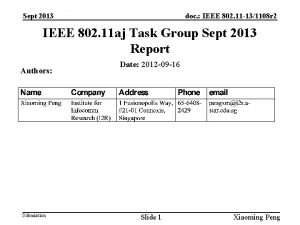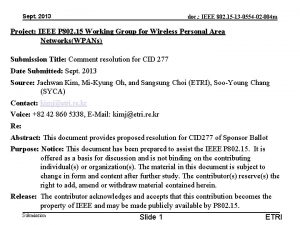Sept 2013 doc IEEE 802 11 131131 r











![Sept. 2013 doc. : IEEE 802. 11 -13/1131 r 0 Reference [1] 11 -09/1039 Sept. 2013 doc. : IEEE 802. 11 -13/1131 r 0 Reference [1] 11 -09/1039](https://slidetodoc.com/presentation_image/296349f85b9400879003d3e2840b3b07/image-12.jpg)





- Slides: 17

Sept. 2013 doc. : IEEE 802. 11 -13/1131 r 0 PHY Abstraction for HEW System Level Simulation Date: 2013 -09 Authors: Name Affiliations Address Phone Email Zhang Jiayin Huawei Technologies No. 2222, Xin Jinqiao Rd. Pudong, Shanghai, China +862138900662 zhangjiayin@huawei. com Ma Chixiang Shanghai machixiang@huawei. com Zhu Jun Shanghai zhujun 75@huawei. com Peter Loc San Jose peterloc@iwirelesstech. com Phillip Barber Dallas pbarber@broadbandmobilet ech. com Edward Au Ottawa edward. au@huawei. com Wookbong Lee Submission LG Electronics wookbong. lee@lge. com Slide 1 Zhang Jiayin (Huawei Technologies)

Sept. 2013 doc. : IEEE 802. 11 -13/1131 r 0 Abstract • A method of MIESM (Mutual Information Effective SINR Mapping) is introduced for PHY abstraction for HEW system level simulation. • In order to fit the channel model and MCS for 11 ac, some adjustment to parameters is proposed Submission Slide 2 Zhang Jiayin (Huawei Technologies)

Sept. 2013 doc. : IEEE 802. 11 -13/1131 r 0 Motivation • To evaluate system performance with more realistic assumptions, some existing dynamic PHY features should be reflected in system level simulation, e. g. – – Submission Adaptive modulation and coding schemes OFDM with Scalable bandwidth ACK transmission (SU/MU)-MIMO, including CSI feedback Slide 3 Zhang Jiayin (Huawei Technologies)

Sept. 2013 doc. : IEEE 802. 11 -13/1131 r 0 Motivation • Complex simulation scenarios impede real-time link level simulation for all communication links in system level simulation. – There will be a large number of APs and STAs deployed in HEW simulation scenario, e. g. tens of APs and hundreds of STAs. – There will be mixed channel models in one simulation scenario, NLOS/LOS, indoor/outdoor. – Different links adopt different transmission modes (e. g. MCS, streams). – It takes a long time to do channel coding/decoding simultaneously for many links, especially with LDPC. Submission Slide 4 Zhang Jiayin (Huawei Technologies)

Sept. 2013 doc. : IEEE 802. 11 -13/1131 r 0 State of the art in Wi-Fi • PHY abstraction is to predict the packet error rate (PER) for a given received channel realization across the OFDM subcarriers used to transmit the coded FEC block. • In early 11 ac, the TG re-investigated PHY abstractions proposed in 11 n for MU-MIMO, but no consensus reached. [1] – Unified “Black Box” [2] • Use of look-up tables giving PHY performance vs. channel conditions via channel capacity • Large computation and storage required – PER prediction [3] • Calculate the effective SNR by assuming AWGN channel during the frame length, and then map effective SNR to PER using mathematical properties of BCC channel coding. • Inaccuracy in complex interference and mobility environment Submission Slide 5 Zhang Jiayin (Huawei Technologies)

Sept. 2013 doc. : IEEE 802. 11 -13/1131 r 0 State of the art in cellular Effective SINR Mapping (ESM) method • Currently, Effective SINR Mapping[4] were widely used in system level simulation for 3 GPP LTE[5] and IEEE 802. 16 m[6] , – Step 1: calculate post SINRs on each OFDM resource element considering the receiver algorithms, such as ZF/MMSE. – Step 2: Calculate the effective SINR ( ) , using the following equation – Step 3: Reference the AWGN link performance curves of different MCSs to obtain the mapping between effective SINR and BLER. • It is similar to PER prediction except for the effective SNR calculation. Submission Slide 6 Zhang Jiayin (Huawei Technologies)

Sept. 2013 doc. : IEEE 802. 11 -13/1131 r 0 Our proposal Mutual Information ESM (MIESM) • Two mapping functions are generally used [4]. – EESM (Exponential ESM): • It is only accurate at high error rate. – MIESM : • Also called RBIR (Received Bit mutual Information Rate) [6] • It is a nonlinear mapping from post SNR to symbol-level mutual information. Submission Slide 7 Zhang Jiayin (Huawei Technologies)

Sept. 2013 doc. : IEEE 802. 11 -13/1131 r 0 MIESM in 11 ac (1) • The effective SNR mapping curves for 11 ac modulations. Submission Slide 8 Zhang Jiayin (Huawei Technologies)

Sept. 2013 doc. : IEEE 802. 11 -13/1131 r 0 MIESM for 11 ac (2) • The predicted PER can be mapped from the effective SNR to BLER curves – BLER performance in AWGN channels. Submission Slide 9 Zhang Jiayin (Huawei Technologies)

Sept. 2013 doc. : IEEE 802. 11 -13/1131 r 0 MIESM in 11 ac (3) • Performance deviation from link level simulation MCS α 1 α 2 MSE 0 0. 33 2 0. 7073 1 0. 83 0. 1 1. 0114 2 0. 95 0. 1 1. 3849 3 0. 74 0. 22 0. 1235 4 0. 89 0. 45 0. 1682 5 0. 86 0. 63 0. 3563 6 0. 91 0. 67 0. 2142 7 0. 93 0. 67 0. 3028 8 0. 89 0. 69 0. 4045 9 0. 92 0. 74 0. 3141 Submission Slide 10 Zhang Jiayin (Huawei Technologies)

Sept. 2013 doc. : IEEE 802. 11 -13/1131 r 0 Summary • MIESM(RBIR) can provide a quick, channel model independent prediction of instantaneous error rate given the post SINR across the resource element of OFDM used to transmit codeword. • It can be used as one of the PHY abstractions for HEW SLS. • Other abstraction methods, e. g. MMIB, can also be used as long as the prediction accuracy can be justified. Submission Slide 11 Zhang Jiayin (Huawei Technologies)
![Sept 2013 doc IEEE 802 11 131131 r 0 Reference 1 11 091039 Sept. 2013 doc. : IEEE 802. 11 -13/1131 r 0 Reference [1] 11 -09/1039](https://slidetodoc.com/presentation_image/296349f85b9400879003d3e2840b3b07/image-12.jpg)
Sept. 2013 doc. : IEEE 802. 11 -13/1131 r 0 Reference [1] 11 -09/1039 r 0 Simulation Methodology Proposal [2] 11 -04/0218 r 3 Unified “Black Box” PHY Abstraction Methodology, Mar. 2004 [3] 11 -04/0174 r 1 PHY Abstraction for System Simulation, Feb. 2004 [4] Karsten Brueninghaus, “Link Performance Models for System Level Simulations of Broadband Radio Access Systems”, PIMRC 2005 [5] 3 GPP TR 25. 892 V 2. 0. 0 “Feasibility Study for OFDM for UTRAN enhancement”, June 2004. [6] IEEE 802. 16 m-08/004 r 5, Jan. 2009 [7] 11 -13/1059 r 0 PHY abstraction for HEW, Sept. 2013 Submission Slide 12 Zhang Jiayin (Huawei Technologies)

Sept. 2013 doc. : IEEE 802. 11 -13/1131 r 0 Appendix 1 • Justification procedures used to get curves in slide 10. [1] Submission Slide 13 Zhang Jiayin (Huawei Technologies)

Sept. 2013 doc. : IEEE 802. 11 -13/1131 r 0 Appendix 2 • Mean Mutual Information per Bit (MMIB) – An alternative method in 16 m [6][7] – It is a nonlinear mapping from post SNR to mutual information per coded bit MIB function QPSK 16 QAM 64 QAM Submission Slide 14 Zhang Jiayin (Huawei Technologies)

Sept. 2013 doc. : IEEE 802. 11 -13/1131 r 0 QPSK, 1/2 BCC Submission Slide 15 Zhang Jiayin (Huawei Technologies)

Sept. 2013 doc. : IEEE 802. 11 -13/1131 r 0 16 QAM, 1/2 BCC Submission Slide 16 Zhang Jiayin (Huawei Technologies)

Sept. 2013 doc. : IEEE 802. 11 -13/1131 r 0 64 QAM, 2/3 BCC Submission Slide 17 Zhang Jiayin (Huawei Technologies)
 Bridges from 802.x to 802.y
Bridges from 802.x to 802.y Bridges from 802.x to 802.y
Bridges from 802.x to 802.y Ieee 802 que es
Ieee 802 que es Ieee 802 standard
Ieee 802 standard 802 15
802 15 802 ieee
802 ieee Ieee 802
Ieee 802 Ieee 802 family
Ieee 802 family Ieee 802 3 compliance
Ieee 802 3 compliance Ieee802.22
Ieee802.22 Arquitetura ieee 802
Arquitetura ieee 802 Sept prefix words
Sept prefix words Candide ou l optimisme
Candide ou l optimisme Cnn10 september 7 2021
Cnn10 september 7 2021 Sept
Sept Trois feuilles mortes poeme
Trois feuilles mortes poeme The seven hills of jerusalem
The seven hills of jerusalem Sept heure moins le quart
Sept heure moins le quart














